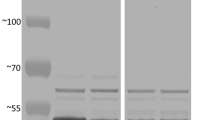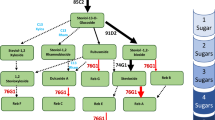Abstract
High-amylose starch is in great demand by the starch industry for its unique functional properties. However, very few high-amylose crop varieties are commercially available. In this paper we describe the generation of very-high-amylose potato starch by genetic modification. We achieved this by simultaneously inhibiting two isoforms of starch branching enzyme to below 1% of the wild-type activities. Starch granule morphology and composition were noticeably altered. Normal, high-molecular-weight amylopectin was absent, whereas the amylose content was increased to levels comparable to the highest commercially available maize starches. In addition, the phosphorus content of the starch was increased more than fivefold. This unique starch, with its high amylose, low amylopectin, and high phosphorus levels, offers novel properties for food and industrial applications.
This is a preview of subscription content, access via your institution
Access options
Subscribe to this journal
Receive 12 print issues and online access
$209.00 per year
only $17.42 per issue
Buy this article
- Purchase on Springer Link
- Instant access to full article PDF
Prices may be subject to local taxes which are calculated during checkout




Similar content being viewed by others
References
Lillford, P.J. & Morrison, A. Structure/function relationship of starches in food. In Starch structure and functionality. (eds Frazier, P.J., Richmond, P. & Donald, A.M.) 1– 8 (The Royal Society of Chemistry, Cambridge, UK; 1997 ).
Heyer, A.G., Lloyd, J.R. & Kossmann, J. Production of modified polymeric carbohydrates. Curr. Opin. Biotechnol. 10, 169–174 (1999).
Smith, A.M. Making starch. Curr. Opin. Plant Biol. 2, 223–229 (1999).
Jobling, S.A. et al. A minor form of starch branching enzyme in potato (Solanum tuberosum L.) tubers has a major effect on starch structure: cloning and characterisation of multiple forms of SBE A. Plant J. 18, 163–171 (1999).
Burton, R.A. et al. Starch branching enzymes belonging to distinct enzyme families are differentially expressed during pea embryo development. Plant J. 7, 3–15 (1995 ).
Commission on Plant Gene Nomenclature. Nomenclature of sequenced plant genes. Plant Mol. Biol. Rep. 12, S1–S109 (1994).
Edwards, A. et al. A combined reduction in activity of starch synthases II and III of potato has novel effects on the starch of tubers. Plant J. 17, 251–261 (1999).
Lloyd, J.R., Landschütze, V. & Kossmann, J. Simultaneous antisense inhibition of two starch synthase isoforms in potato tubers leads to accumulation of grossly modified amylopectin. Biochem. J. 338, 515–521 (1999).
Safford, R. et al. Consequences of antisense RNA inhibition of starch branching enzyme activity on properties of potato starch. Carbohydr. Polym. 35 , 155–168 (1998).
Tjaden, J., Möhlmann, T., Kampfenkel, K., Henrichs, G. & Neuhaus, H.E. Altered plastidic ATP/ADP-transporter activity influences potato (Solanum tuberosum L.) tuber morphology, yield and composition of tuber starch. Plant J. 16, 531–540 (1998).
Shi, Y.-C., Capitani, T., Trzasko, P. & Jeffcoat, R. Molecular structure of a low-amylopectin starch and other high-amylose maize starches. J. Cereal Sci. 27, 289– 299 (1998).
Cheetham, N.W.H. & Tao, L. The effects of amylose content on the molecular size of amylose, and on the distribution of amylopectin chain length in maize starches. Carbohydr. Polym. 33 , 251–261 (1998).
Sidebottom, C., Kirkland, M., Strongitharm, B. & Jeffcoat, R. Characterization of the difference of starch branching enzyme activities in normal and low-amylopectin maize during kernel development. J. Cereal Sci. 27, 279–287 (1998).
Morrison, W.R. & Laignelet, B. An improved colourimetric procedure for determining apparent total amylose in cereal and other starches. J. Cereal Sci. 1, 9– 20 (1983).
Acknowledgements
The authors wish to thank Chris Sidebottom and Martine Debet for their contributions in the early phase of the project, Tina Sanders, Alice Belton, Alison Burrows, and Bob Cowper for their technical assistance.
Author information
Authors and Affiliations
Corresponding author
Rights and permissions
About this article
Cite this article
Schwall, G., Safford, R., Westcott, R. et al. Production of very-high-amylose potato starch by inhibition of SBE A and B. Nat Biotechnol 18, 551–554 (2000). https://doi.org/10.1038/75427
Received:
Accepted:
Issue Date:
DOI: https://doi.org/10.1038/75427
This article is cited by
-
Evaluation of altered starch mutants and identification of candidate genes responsible for starch variation in wheat
BMC Plant Biology (2023)
-
Suppressed expression of starch branching enzyme 1 and 2 increases resistant starch and amylose content and modifies amylopectin structure in cassava
Plant Molecular Biology (2022)
-
Starch branching enzymes as putative determinants of postharvest quality in horticultural crops
BMC Plant Biology (2021)
-
Amylose starch with no detectable branching developed through DNA-free CRISPR-Cas9 mediated mutagenesis of two starch branching enzymes in potato
Scientific Reports (2021)
-
Potato Starch: a Review of Physicochemical, Functional and Nutritional Properties
American Journal of Potato Research (2019)



